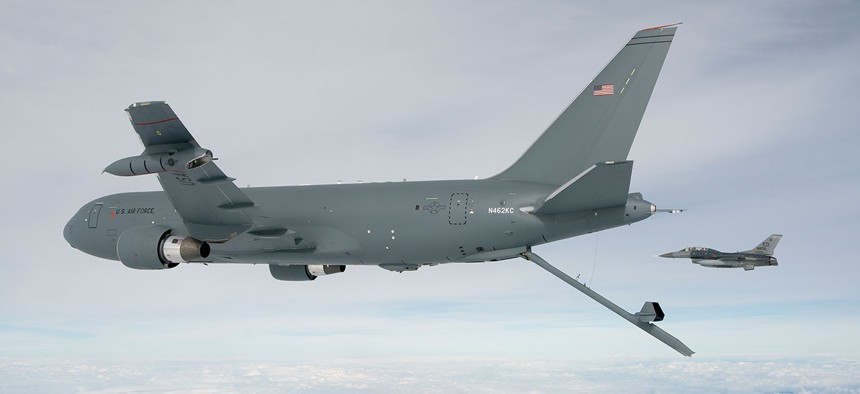How Boeing Aims To Fix Its Broken Tanker
New hardware on the balky refueling boom will be tested next month.
Boeing says it has figured out how to fix the refueling boom on its brand-new Air Force KC-46 tanker. Next month, the company plans to test a new piece of hardware meant to remedy a design problem that has prevented the tanker from refueling C-17 cargo planes.
“We will be flying the aircraft [with the modified boom] in the July timeframe,” Leanne Caret, president and CEO of Boeing’s defense unit, said Wednesday at the Deutsche Bank Global Industrials and Materials Summit.
The boom, essentially a pipe that descends from the tail of the tanker to pass fuel to the receiving aircraft, telescopes in and out as tanker and receiver fly about a dozen feet apart. While the KC-46 has successfully refueled small F-16 fighter jets, the larger C-17 places “higher than expected” pressures, called axial loads, on the boom, said Caroline Hutcheson, a Boeing spokeswoman.
“This control system must maintain enough contact pressure to keep the refueling nozzle connected, but not too much pressure as to place excessive force on the tanker or receiver aircraft structure,” Hutcheson said.
The company had hoped to correct the boom problem with a software update. That fix “worked to a degree in flight test, [but] it wasn’t as robust as we wanted,” Dennis Muilenburg, Boeing chairman, president and CEO, said June 2 at the Bernstein Strategic Decisions Conference.
Instead, Boeing is going with a “hardware solution” that is “more robust for the long run,” he said.
The company will install a “hydraulic relief valve system” that is about the size of a paperback book, Hutcheson said. “Two bypass valves are inserted into the hydraulic system so that if loads build up on the boom, the valves open to relieve the pressure,” she said.
The system is similar to equipment used on the booms of the Air Force KC-10 and KC-767 tankers, which are flown by the Japanese and Italian air forces.
“The Air Force is comfortable with Boeing’s hardware approach, given it is similar to how axial load relief is accomplished on our legacy KC-10 tanker,” said Daryl Mayer, an Air Force spokesman for the KC-46 program at Wright-Patterson Air Force Base in Ohio. “We look forward to reviewing the details of Boeing’s design of the hydraulic relief valve on the KC-46 to ensure it will properly alleviate axial loads in flight.”
The boom problem has prompted the service to delay awarding a contract for more aircraft. Certification and qualification issues will cause Boeing to miss a contractual deadline to deliver 18 planes to the Air Force by August 2017.
Muilenburg said the company would still build 18 tankers by August 2017, but those planes “won’t be completely certified.” Air Force officials said all 18 planes would not be delivered until January 2018.
What penalties will Boeing face for missing the delivery deadline?
“As with any contract schedule breach, the Air Force will seek consideration commensurate with the impact of the breach,” said Maj. Robert Leese, a service spokesman at the Pentagon. The Air Force will “secure consideration from Boeing” as it now resets the project’s schedule.
The Air Force’s contract with Boeing does not list specific penalties for missing schedule deadlines, Leese said.
Boeing executives say they are evaluating the financial impact the boom fix will have on the tanker project, whose various developmental problems have already cost the company $1.5 billion. Under the terms of the contract, Boeing, not the Pentagon, must pay for cost overruns.
The firm will likely need to pony up more money to fix the boom. In a recent note to investors, defense consultant Jim McAleese, who runs Virginia-based McAleese and Associates, said to “expect potential for additional ... KC-46 charge” when Boeing reports second-quarter earnings.
“We'll work through the local financial impacts of that and cash timing of that, part of our normal financial process,” Muilenburg said. “So, that analysis is underway.”
Boeing has proposed several types of refueling booms to the Air Force over the years. In August 2007, it touted the “fifth-generation boom” on its Japanese and Italian KC-767 tankers. Later that year, Boeing cited the “sixth-generation boom” it was proposing for the U.S. Air Force.
The Air Force instead chose Northrop Grumman and Airbus to build a new tanker based on the A330 jetliner in February 2008, but that award was overturned after Boeing contested the contract. When Pentagon reopened the tanker contest in 2010, Boeing touted “a new-generation fly-by-wire boom.”
And when the Air Force chose Boeing’s KC-46 proposal, the firm said its tanker “features an advanced KC-10 boom with an expanded refueling envelope, increased fuel offload rate and fly-by-wire control system.”
Boeing considers the KC-46 a “franchise program” worth upwards of $80 billion. While the Air Force plans to buy 179 KC-46 tankers for about $30 billion, Boeing believes the military could ultimately buy as many as 400 planes to replace all of its KC-135s.
In addition to the initial sale of each plane, the company expects to make billions of dollars from maintenance and logistics work over the tankers’ expected decades of service.
Caret said she works on the KC-46 project on a daily basis. Even though she’s based in St. Louis, Caret is routinely in Seattle, where Boeing builds the plane, to keep an eye on the project.
NEXT STORY: The Rocky Obama-Sanders Relationship




